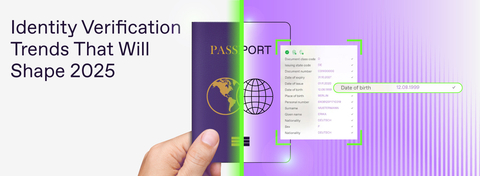 BUSINESS WIRE
BUSINESS WIRE


Key Identity Verification Trends for 2025: Regula's Expert Insights
Kristina – ks@regulaforensics.com
Regula, a global developer of forensic devices and identity verification solutions, unveils its vision for the identity verification (IDV) industry in 2025. As new and persistent threats converge with evolving regulations and user expectations, they bring to life new requests for significant technological advancem
ents in IDV.
This press release features multimedia. View the full release here: https://www.businesswire.com/news/home/20250121753818/en/

Regula's experts share their insights into how identity verification will evolve in 2025 (Graphic: Regula)
Threats shaping the IDV landscape
The rise in identity fraud over the past two years has significantly impacted all industries, especially Finance, Banking, FinTech, and Crypto. With deepfakes threatening every second company around the world, businesses won’t be able to stand out without liveness checks, both for biometrics and documents. However, organizations can’t blindly rely on this method as-is. They will have to introduce signal source control via hardware-enabled solutions. With deepfakes being so deeply realistic now, humans often fail to distinguish between what is fake and what is real. That is why checking signal source integrity is crucial, as it helps ensure that no injection is done during the video session within the IDV process.
Also, businesses will further reinforce their biometric verification methods, such as facial recognition, fingerprint scanning, and voice identification, as they add additional defense.
Interestingly, traditional threats like fake IDs and synthetic fraud still account for the majority of identity fraud attempts. This highlights the need for businesses to balance preparing for sophisticated future attacks with addressing the more prevalent threats of today.
Regulations and user expectations: Growing demand and pressure
The IDV landscape is evolving due to stricter laws, rising user expectations, and new workforce demands. Governments are enforcing tighter age verification to protect minors and regulate restricted services. This will be driving further technologies like biometric age estimation.
Users seek fast, personalized IDV solutions, while businesses require flexible systems. So, the IDV industry will continue developing toward user-centric design, where convenience and personalization are prioritized.
Additionally, a new IDV user category is emerging: the workforce. In the era of remote and hybrid work, identity verification for employees is critical to prevent fraud, such as fake identities and ghost employees.
Technological shifts
The evolving challenges of fraud, compliance, and user demands are driving advancements in IDV technologies and the adoption of new digital identity documents like the Digital Travel Credential (DTC), mobile driver’s licenses (mDLs), digital identity, etc.
To ensure more efficient fraud prevention, identity verification will extend beyond traditional document and biometric checks to include additional methods, such as direct validation against governments’ or issuing authorities’ databases. Also, IDV technologies will be more deeply integrated with other IT solutions deployed in organizations to create secure ecosystems.
Journey Time Orchestration (JTO) is gaining traction, offering a dynamic platform approach to managing identity tasks across the user journey by unifying biometrics, passwords, and third-party systems to balance security and convenience.
Last but not least, AI and ML technologies will be gaining momentum in identity verification. They have been used in IDV solutions for some time already, but their influence will become more tangible as AI-generated fraud evolves into a very significant threat to businesses worldwide.
“The identity verification industry is driven by the multiple forces of advanced threats, rising user demands, tightening regulation, and technological advancements. As we move into 2025, the challenge will be to create solutions that not only address sophisticated fraud but also prioritize user convenience and regulatory compliance,” said Ihar Kliashchou, Chief Technology Officer at Regula.
To get more insights on the trends that will shape IDV in the coming year, read our blog article.
About Regula
Regula is a global developer of forensic devices and identity verification solutions. With our 30+ years of experience in forensic research and the most comprehensive library of document templates in the world, we create breakthrough technologies for document and biometric verification. Our hardware and software solutions allow over 1,000 organizations and 80 border control authorities globally to provide top-notch client service without compromising safety, security, or speed. Regula has been repeatedly named a Representative Vendor in the Gartner® Market Guide for Identity Verification.
Learn more at www.regulaforensics.com.
View source version on businesswire.com: https://www.businesswire.com/news/home/20250121753818/en/


